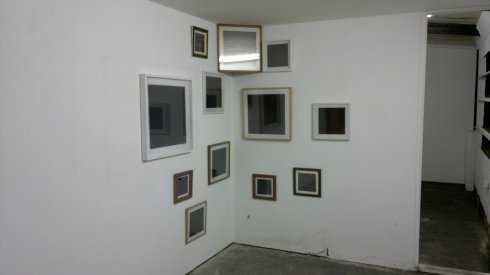It was recently pointed out to me that there has been a lot of minimal art produced recently, and the exhibitions this article discusses feature minimal and monochromatic works, but can minimalism go too far?
Florian Pumhösl’s part of the current exhibition at Raven Row consists of two floors filled with a series of minimal works on glass. This choice of unframed medium seems to reflect upon Joseph Kosuth‘s works including Clear Square Glass Leaning (1965) and No Number #1 (+216, After Augustine’s Confessions) (1989), and to the latter of these there also seems to be a link in David Batchelor‘s Shelf-like No. 5 (Green) (1999), currently on display at the Whitechapel Gallery in their latest exhibition of the Government Art Collection. However, where Kosuth applied text to the medium using Letraset and later silkscreen, Pumhösl has composed and painted a series of abstract black lines, numbering between two and six on each piece. These lines might describe journeys, lines of communication, horizons, or statistical graphs, but there is no information within the work for viewers to read the artist’s intention or act. To the viewer these are simply random lines, some arranged so they create intersections and others vaguely parallel, floating in the liquid plane of the glass, sometimes alike part of paintings by Wassily Kandinsky.
Whilst Pumhösl’s work fits within the broad nature of minimalism and perhaps Abstract Expressionism, The Mews Project Space is hosting an exhibition of monochromatic works, which critically address minimalism and its practices from within. In the first room of Dark Matter Jonathan Lewis has set out to recreate the installation conditions of Kasimir Malevich‘s seminal Suprematist exhibition, The Last Futurist Exhibition (1915), but Lewis uses only a series of prints of Black Square on White in different size and style frames and digital printing means and materials. However the focus of The End (2011) is on the pixelation of the image, which unlike Lewis’s previous work is due to the prints being taken from a very low-resolution image found online. This includes a rather bizarre square of different shade off-white pixels in each corner like an unreadable QR code or the tags within a graphic design software package for manipulating the dimensions of a selected image. Then a greyish line of pixels forms a border between the two areas, as though the image could be of a black surface over layered with a white mount board casting a slight shadow. Such is the case that online information, particularly that resourced from search engines that pick up any text on a page, can be confused between original pieces and things inspired by a master, hence it is possible that this may not be an image of the original. Consequently the work questions the capability of communication of knowledge and ideas through the internet and the actual minimalism of artworks including Malevich’s. Do they conform to machine-accurate straight lines or is the presence of human nature visible in brushstrokes and minor imperfections?
Opposite, Andreas Schmidt’s Free Porn critiques censorship on Google Images suggesting that there is either too much censorship or that the pornographic images obscured in this work are too easily accessible and without payment to the models and photographer. Furthermore Schmidt may be critiquing several layers of censorship; that of the images, the power of Google and other search providers to control what you can find on the internet, and also that within the art world.










